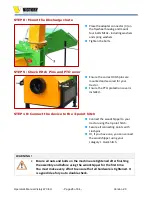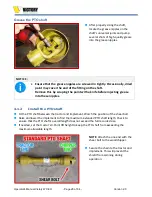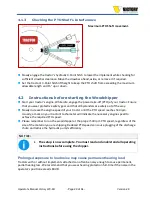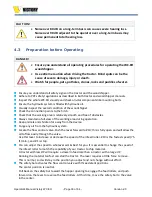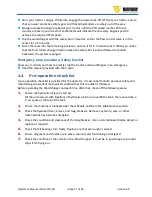
Operator’s Manual Victory WC-8H
- Page 16 of 64 -
Version 2.0
3.7
SAFETY AND HEALTH MEASURES WHEN USING
HYDRAULIC FLUID
Anyone working on installations where hydraulic fluid, lubricating oil, grease, or preservatives are
used must observe the following rules:
◼
Do not remove the protection sleeves from the hydraulic hoses.
◼
Avoid prolonged contact of the liquid with the skin. In the event of contact, carefully cleanse
the skin. Wear clothing that is free of this liquid. Also, be careful when eating and drinking
during the operation.
◼
Avoid skin contact with liquids over 60°C or hot machine parts.
◼
Avoid eye contact; if this happens, cleanse with plenty of water and contact a doctor.
◼
Liquid storage must follow official guidelines; pay attention to fire extinguishers and emergency
exits.
◼
Permanently remove spilled liquids immediately to prevent them from slipping.
◼
Hydraulic liquids should not get into the ground or in surface water.
◼
Avoid high-pressure fluids hazards. Escaping fluid under pressure can penetrate the skin
causing severe injury.
◼
Avoid the hazard by relieving pressure before disconnecting hydraulic lines.
◼
Never try to stop leaks from the system by hand.
◼
Have used liquids removed and recycled by specialized companies.
◼
Use a piece of paper or cardboard, not body parts, to check for suspected leaks. Wear
protective gloves and safety glasses or goggles when working with hydraulic systems.
◼
If an accident occurs, see a doctor immediately. Always treat any fluid injected into the skin
within a few hours.
3.8
INFEED ROLLERS SAFETY
◼
The infeed rollers can cause severe injury or death. Keep hands, feet, and clothing away from
the feed rollers and flywheel chipper knife blades.
◼
Never climb onto the feed chute when the unit is operating or running.
◼
Do not reach inside. Keep proper balance and footing.
◼
Never allow passengers to ride on the feed chute.
◼
When feeding material into the feed roller, wear eye, face, and hearing protection.
◼
Release material and stand to the side of the feed chute.
3.9
PTO DRIVELINE SAFETY
Agriculture and forestry are very hazardous occupations.
Today’s farmer spends long hours
close
to increasingly complex and powerful machinery.
Everyone from the component supplier and the company that manufacturers and assembles the
machinery to the dealers and ultimately the actual user must keep safety in mind to avoid
accidents.
The safety rules below relate to the driveline of agricultural implements, general safety literature,
and the standards published by the American Society of Agricultural Engineers.
◼
Read and follow instructions on PTO safety decals.

























